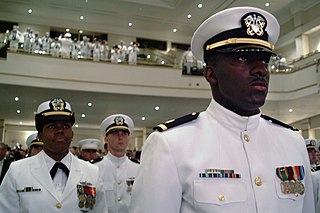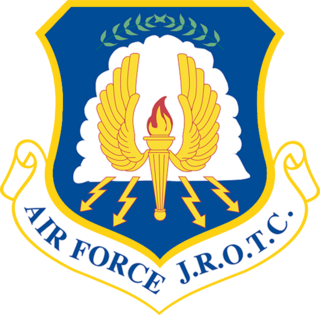
The Legion of Merit (LOM) is a military award of the United States Armed Forces that is given for exceptionally meritorious conduct in the performance of outstanding services and achievements. The decoration is issued to members of the eight uniformed services of the United States as well as to military and political figures of foreign governments.

The Reserve Officers' Training Corps is a group of college- and university-based officer-training programs for training commissioned officers of the United States Armed Forces.
The National Defense Service Medal (NDSM) is a service award of the United States Armed Forces established by President Dwight D. Eisenhower in 1953. It was awarded to every member of the U.S. Armed Forces who served during any one of four specified periods of armed conflict or national emergency from June 27, 1950 through December 31, 2022. Combat or "in theater" service is not a requirement for the award.
The Air and Space Training Ribbon (ASTR) is the lowest military award of the United States Air Force and United States Space Force, ranking only above foreign military awards.
The World War II Victory Medal is a service medal of the United States military which was established by an Act of Congress on 6 July 1945 and promulgated by Section V, War Department Bulletin 12, 1945.
Officer Cadet is a rank held by military cadets during their training to become commissioned officers. In the United Kingdom, the rank is also used by members of University Royal Naval Units, University Officer Training Corps and University Air Squadron; however, these are not trainee officers with many not choosing a career in the armed forces.

A service stripe is an embroidered diagonal stripe worn on the sleeve(s) of some military and paramilitary uniforms. In the case of the United States military, service stripes are authorized for wear by enlisted personnel on the lower part of the sleeve of a uniform to denote length of service. Service stripes vary in size and in color.
The American Defense Service Medal was a military award of the United States Armed Forces, established by Executive Order 8808, by President Franklin D. Roosevelt, on June 28, 1941. The medal was intended to recognize those military service members who had served on active duty between September 8, 1939, and December 7, 1941.

The Virginia Tech Corps of Cadets (VTCC) is the military component of the student body at Virginia Polytechnic Institute and State University. Cadets live together in residence halls, attend morning formation, wear a distinctive uniform, and receive an intensive military and leadership educational experience similar to that available at the United States service academies. The Corps of Cadets has existed from the founding of the Virginia Agricultural and Mechanical College in 1872 to the present-day institution of Virginia Tech, which is designated a senior military college by federal law. As of August 2021, about 1,200 cadets are currently enrolled in the program.

The Air Force Reserve Officers' Training Corps (AFROTC) is one of the three primary commissioning sources for officers in the United States Air Force and United States Space Force, the other two being the United States Air Force Academy (USAFA) and Air Force Officer Training School (OTS). A subordinate command of the Air University within the Air Education and Training Command (AETC), AFROTC is aligned under the Jeanne M. Holm Center for Officer Accessions and Citizen Development at Maxwell AFB, Alabama. The Holm Center, formerly known as the Air Force Officer Accession and Training Schools (AFOATS), retains direct responsibility for both AFROTC and OTS.

The University of Oklahoma Army ROTC is the primary officer training and commissioning program at the University of Oklahoma and one of the oldest in the nation, having existed in some form since the First World War. It is known as the "Sooner Battalion" and is notable for having produced thousands of officers for the United States Army, including 19 general officers. It is led by three officers and two noncommissioned officers.

The ROTC Medal for Heroism is the highest United States Department of the Army medal awarded exclusively to Army Reserve Officers' Training Corps cadets. This award is presented to cadets who perform acts of heroism. As with other Department of the Army decorations, the award consists of a medal and ribbon, accompanied by DA Form 638. In the Army, this award is also known as the Medal of Heroism.

The Ranger Challenge Tab is the only United States Department of the Army individual qualification tab awarded exclusively to Reserve Officers' Training Corps cadets, and approved by the Institute of Heraldry. This award is presented annually to cadets who compete in regional ROTC Ranger Challenge competitions.

The Penn State Army Reserve Officers' Training Corps is the ROTC department at The Pennsylvania State University. It is the largest branch of the ROTC program at the school, which also has Naval ROTC and Air Force ROTC. The Nittany Lion Battalion (NLB) is one of the 41 participating battalions in the 2nd Reserve Officers' Training Corps Brigade, also known as the Freedom Brigade. The brigade is headquartered at Fort Dix, NJ, and comprises ROTC programs in the North Eastern United States including CT, MA, ME, NH, NJ, NY, PA, RI, and VT.
Awards and decorations of the Armed Forces of the Philippines are military decorations which recognize service and personal accomplishments while a member of the Armed Forces of the Philippines (AFP).
The National Defense Cadet Corps (NDCC) was the forerunner to the current Junior Reserve Officers' Training Corps (JROTC) program and is essentially identical to it with just one exception: The NDCC is funded internally by the schools that opt for a military training system like JROTC but without any financial assistance from the Department of Defense. Therefore, the schools bear all costs associated with the program, including military instructor salaries, uniforms, training materials, and any other program expenses. As of 2012, there were three remaining US Army NDCC units in the United States. The US Navy began its program in April 2011. The US Marine Corps and the US Air Force also operate NDCC programs.

The Army Reserve Officer Training Corps (AROTC) is the United States Army component of the Reserve Officers' Training Corps. It is the largest Reserve Officer Training Corps (ROTC) program which is a group of college and university-based officer training programs for training commissioned officers for the United States Army and its reserves components: the Army Reserves and the Army National Guard. There are over 30,000 Army ROTC cadets enrolled in 274 ROTC programs at major universities throughout the United States. These schools are categorized as Military Colleges (MC), Military Junior Colleges (MJC) and Civilian Colleges (CC).

The Junior Reserve Officer Training Corps is a federal program sponsored by the United States Armed Forces in high schools and also in some middle schools across the United States and at US military bases across the world. The program was originally created as part of the National Defense Act of 1916 and later expanded under the 1964 ROTC Vitalization Act.

Air Force Junior Reserve Officer Training Corps (AFJROTC) is a subdivision of the Junior Reserve Officer Training Corps (JROTC). JROTC is a junior military science elective class that is offered in many high schools across the United States. The class is the high school version of the college ROTC. The Air Force division of JROTC is composed of physical training, aerospace science academic classes, and leadership skill creation. Outside of the formal class, there are extra-curricular teams that cadets may participate in to create qualities of leadership and followership. Unlike the collegiate version of ROTC, upon completion of JROTC there is no military service required. This allows the youth of the United States to experience the military without having long-term commitments.
The following is a list of the orders and medals issued by the People's Republic of China since its founding. The Working Committee of Party and State Merit and Honour Commendation is responsible for coordinating the work of Party and state merit and honor commendation.
















